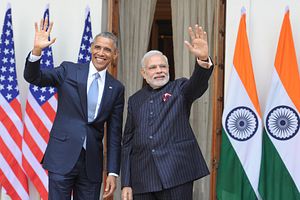The United States and India will hold their first-ever Strategic and Commercial Dialogue next week in Washington. This strategic and commercial consolidation is a little-noticed but important outcome of President Obama’s meeting with Prime Minister Modi at the Indian Republic Day last January. Now the Obama administration is pulling out all the stops to make this U.S. engagement a success and a key demonstration that the administration’s “rebalance to Asia” is more than just rhetoric.
The Modi administration is reciprocating by sending some of its brightest stars to the meeting and following-up with another visit from the Prime Minister himself. His trip will include a visit to Silicon Valley to see how the U.S. does innovation and culminate in an unprecedented third- within- a -year summit with Obama in New York on September 28. Chinese President Xi Jinping’s visit to the White House on September 24 -25 occurs between the U.S.-India dialogue and the Modi summit – a sequence that will not be lost on Chinese policy makers. Nor will the virtually simultaneous visit to Washington of Pope Francis featuring a protection of the earth theme be ignored as Obama tries to push India toward a commitment on climate change, as he previously did China. Obama has declared climate change a strategic priority. An Indian commitment could pave the way for a substantive agreement in Paris this December.
Indeed, clean energy and its positive effects on the environment will be central to a U.S.-India energy dialogue that will occur the day before and feed into the strategic and commercial meeting. Indian Minister of New and Renewable Energy, Power, and Coal Piyush Goyal will confer with his U.S. counterpart, Energy Secretary Ernie Moniz.
Just after the energy conference and just before the strategic and commercial dialogue, Vice President Joe Biden, Secretary of State John Kerry, Secretary of Commerce Penny Pritzker, and visiting Indian ministers will headline the US-India Business Council annual dinner. A CEO forum and The Energy Research Institute (TERI) will incorporate major leaders of U.S. and Indian business into the agenda.
The prominence being given commerce and business underlines basic realities regarding the U.S.-India economic relationship.
The days of government action being the driving force in U.S.-India economic engagement are over. A “green revolution” aid model, i.e. provision of U.S. technology and resources on a non-commercial basis, no longer has much relevance in the U.S.-Indian context. The U.S. government acting alone simply does not have the resources to make much difference to economic growth in India even though India needs outside help. At times this seems hard for the Indian side to understand and even harder for the U.S. side to admit. Today U.S.-India economic engagement must be driven largely by the private sector on commercial terms. The opportunities for public-private cooperation to fuel mutually beneficial economic development are immense and the necessity for policy coordination is essential. Thus, there is a need for combining strategic and commercial considerations.
However, strategic and commercial factors do not always operate in virtuous circles. They can result in vicious downward spirals as well. Economic and commercial engagement gone awry can drive the world’s two largest democracies apart as well as bring them together. India has just lost a WTO dispute brought by the U.S. about local content in solar projects. India plans to appeal. Less than two years ago, a U.S. business coalition got more than 170 members of Congress to sign on to a letter questioning the fairness of Indian trade practices and instigated a highly critical report of the U.S. International Trade Commission. The ITC is due to issue a follow-up report soon, and it will not be entirely favorable to India.
More importantly, the U.S. and Indian economic models presently may not be sufficiently compatible to support a long-term strategic partnership. Further reforms are needed on both sides. State-owned enterprises are widespread at all levels of Indian government and often make a mockery of the term “free enterprise.” The fundamental economic reforms that drove closer U.S.-Indian strategic relations beginning in the early 1990s have once again stalled. Even the word “privatization” is anathema to large segments of the Indian political establishment. The euphemism “disinvestment” is used to try to get around this difficulty, but the fact remains that the dead hand of governmental bureaucracy still directly controls large segments of the Indian economy.
Nor should the United States be complacent in a belief that it has perfected an economic model that works for promotion of growth and prosperity in India. Neither India nor the rest of the world has forgotten that the great recession of 2008 -2011 began with a meltdown in U.S. financial markets. A system that tolerates – some say “promotes” – vast swings in economic stability and provides income inequality that caters to the top one-half of 1 percent is not wholly attractive to a nation that has 400 million of some of the poorest people on earth.
Unquestionably, economic engagement on commercial terms has been a driver in the ability of the United States and India to move from estrangement to cooperation on strategic issues. The eight days stretching from the U.S.-India energy dialogue through the strategic and commercial dialogue to Modi UN and Silicon Valley visits and culminating in yet another Obama-Modi summit may prove to be pivotal in U.S. Indian relations. Or this sequence of events may be just window-dressing in a seemingly endless string of U.S.-India discussions and photo ops – overshadowed perhaps by the visits of a Catholic Pope and a Chinese President. However, if the world’s largest democracies are to provide the dynamism for a rebalancing toward Asia, these dialogues must be more than just talk: they must show results.
Raymond E. Vickery Jr. is a Global Fellow at the Woodrow Wilson Center; Of Counsel at Hogan Lovells; Senior Advisor at Albright Stonebridge; and a former Assistant Secretary of Commerce, Trade Development, in the Clinton Administration. The opinions expressed in this pieces are solely those of the author.

































